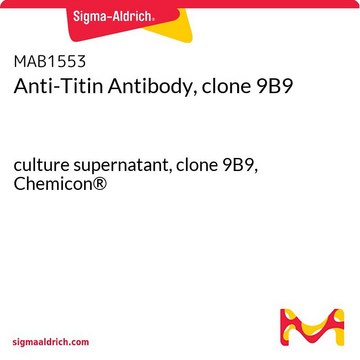T9030
Monoclonal Anti-Titin antibody produced in mouse
clone T11, ascites fluid
Sinônimo(s):
Anti-CMD1G, Anti-CMH9, Anti-CMPD4, Anti-EOMFC, Anti-HMERF, Anti-LGMD2J, Anti-LGMDR10, Anti-MYLK5, Anti-SALMY, Anti-TMD
About This Item
Produtos recomendados
fonte biológica
mouse
conjugado
unconjugated
forma do anticorpo
ascites fluid
tipo de produto de anticorpo
primary antibodies
clone
T11, monoclonal
contém
15 mM sodium azide
reatividade de espécies
vertebrates, chicken
técnica(s)
electron microscopy: suitable
immunohistochemistry (frozen sections): suitable
indirect immunofluorescence: 1:1,000 using frozen tissue sections of animal skeletal muscle
western blot: suitable
Isotipo
IgG2b
Condições de expedição
dry ice
temperatura de armazenamento
−20°C
modificação pós-traducional do alvo
unmodified
Informações sobre genes
chicken ... TTN(424126)
Categorias relacionadas
Descrição geral
Especificidade
Imunogênio
Aplicação
- western blotting
- antibody staining
- immunofluorescence microscopy
- immunohistochemistry
Ações bioquímicas/fisiológicas
Exoneração de responsabilidade
Não está encontrando o produto certo?
Experimente o nosso Ferramenta de seleção de produtos.
Código de classe de armazenamento
12 - Non Combustible Liquids
Classe de risco de água (WGK)
nwg
Ponto de fulgor (°F)
Not applicable
Ponto de fulgor (°C)
Not applicable
Escolha uma das versões mais recentes:
Já possui este produto?
Encontre a documentação dos produtos que você adquiriu recentemente na biblioteca de documentos.
Os clientes também visualizaram
Nossa equipe de cientistas tem experiência em todas as áreas de pesquisa, incluindo Life Sciences, ciência de materiais, síntese química, cromatografia, química analítica e muitas outras.
Entre em contato com a assistência técnica










